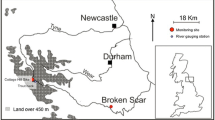Abstract
A stochastic ecological model with an integrated equilibrium temperature model was developed to predict microalgae growth and phosphorus removal in cold region waste stabilization ponds (WSPs). The model utilized a Monte Carlo simulation to account for parameter uncertainty. The equilibrium temperature model was parameterized using field data collected from two WSPs in Nunavut, Canada, from 2012 to 2014. The equilibrium temperature model provided good agreement with field data on a daily time step. The full model was run using historic (1956–2005) temperature and solar radiation data from five communities (Baker Lake, Cambridge Bay, Coral Harbour, Hall Beach, Resolute) in Nunavut, Canada. The communities represented a range of geographical locations and environmental conditions. Logistic regression on pooled model outputs showed that mean July temperature and mean treatment season temperature (June 1–September 15, ice-free period) provided the best predictors for microalgae growth. They had a predictive success rate of 93 and 88%, respectively. The modelled threshold (50% probability from the Monte Carlo simulation) for microalgae growth was 8.7 and 5.6 °C for the July temperature and mean treatment season temperature, respectively. The logistic regression was applied to each community (except Sanikiluaq) in Nunavut using historic climate data and a probability of microalgae growth was calculated. Based on the model results, soluble phosphorus concentrations consistent with secondary treatment could be achieved if WSP depth is less than 2 m. The model demonstrated a robust method to predict whether a microalgae bloom will occur under a range of model parameters.








Similar content being viewed by others
References
Asaeda T, Van Bon T (1997) Modelling the effects of macrophytes on algal blooming in eutrophic shallow lakes. Ecol Model 104(2):261–287
Beran B, Kargi F (2005) A dynamic mathematical model for wastewater stabilization ponds. Ecol Model 181(1):39–57
Blanc G, Agarkova I, Grimwood J, Kuo A, Brueggeman A, Dunigan DD, Gurnon J, Ladunga I, Lindquist E, Lucas S, Pangilinan J, Pröschold T, Salamov A, Schmutz J, Weeks D, Yamada T, Lomsadze A, Borodovsky M, Claverie J, Grigoriev IV, Van Etten JL (2012) The genome of the polar eukaryotic microalga Coccomyxa subellipsoidea reveals traits of cold adaptation. Genome Biol 13(5):R39
Caissie D, Satish MG, El-Jabi N (2005) Predicting river water temperatures using the equilibrium temperature concept with application on Miramichi River catchments (New Brunswick, Canada). Hydrol Process 19(11):2137–2159
Cerco CF, Cole T (1995) User’s guide to the CE-QUAL-ICM three-dimensional eutrophication model. US Army Corps of Engineers, Technical Report AL-95-15.
Dauta A, Devaux J, Piquemal F, Boumnich L (1990) Growth rate of four freshwater algae in relation to light and temperature. Hydrobiologia 207(1):221–226
Diehl S (2002) Phytoplankton, light, and nutrients in a gradient of mixing depths: theory. Ecology 83(2):386–398
Fritz JJ, Middleton AC, Meredith DD (1979) Dynamic process modeling of wastewater stabilization ponds. J Water Pollut Control Fed:2724–2743
Hébert C, Caissie D, Satish MG, El-Jabi N (2015) Predicting hourly stream temperatures using the equilibrium temperature model. J Water Resour Prot 7(4):322
Johnson K (2008) Advancing wastewater treatment in Inuit regions of Canada. Presented at, Western Canada Water and Wastewater Association Conference, Regina, Canada
Johnson K, Craig G, Spry S (1998) Design and construction of sewage lagoon in Grise Fiord, NWT. Presented at: International Conference on Permafrost, Yellowknife, Can Underwrit
Krumhansl KA, Krkosek WH, Greenwood M, Ragush C, Schmidt J, Grant J, Barrell J, Lu L, Lam B, Gagnon GA, Jamieson RC (2014) Assessment of Arctic community wastewater impacts on marine benthic invertebrates. Environ Sci Technol 49(2):760–766
Moreno-Grau S, Garcia-Sanchez A, Moreno-Clavel J, Serrano-Aniorte J, Moreno-Grau MD (1996) A mathematical model for waste water stabilization ponds with macrophytes and microphytes. Ecol Model 91(1):77–103
Obayashi Y, Tanoue E (2002) Growth and mortality rates of phytoplankton in the northwestern North Pacific estimated by the dilution method and HPLC pigment analysis. J Exp Mar Biol Ecol 280(1):33–52
Quayle WC, Peck LS, Peat H, Ellis-Evans JC, Harrigan PR (2002) Extreme responses to climate change in Antarctic lakes. Science 295(5555):645–645
Ragush CM, Schmidt JJ, Krkosek WH, Gagnon GA, Truelstrup-Hansen L, Jamieson RC (2015) Performance of municipal waste stabilization ponds in the Canadian Arctic. Ecol Eng 83:413–421
R Core Team (2015) R: A language and environment for statistical computing. R Foundation for Statistical Computing, Vienna, Austria. http://www.R-project.org/
Schmidt JJ, Ragush CM, Krkosek WH, Gagnon GA, Jamieson RC (2016a) Characterizing phosphorus removal in passive arctic waste stabilization ponds. Arctic Science 2(1):1–14
Schmidt JJ, Gagnon GA, Jamieson RC (2016b) Microalgae growth and phosphorus uptake in wastewater under simulated cold region conditions. Under Review Ecological Engineering Submitted: March 9:2016
Seaburg KG, Parked BC, Wharton RA, Simmons GM (1981) Temperature-growth responses of algal isolates from Antarctic oases. J Phycol 17(4):353–360
Shilton A (2005) Pond treatment technology. IWA publishing, London
Smol JP, Wolfe AP, Birks HJB, Douglas MS, Jones VJ, Korhola A, Pienitz R, Rühland K, Sorvari S, Antoniades D, Brooks SJ, Fallu M, Hughes M, Keatley BE, Laing TE, Michelutti N, Nazarova L, Nyman M, Paterson AM, Perren B, Quinlan R, Pautio M, Saulnier-Talbot E, Siitonen S, Solovieva N, Weckström J (2005) Climate-driven regime shifts in the biological communities of arctic lakes. Proc Natl Acad Sci U S A 102(12):4397–4402
Steele JH (1962) Environmental control of photosynthesis in the sea. Limnol Oceanogr 7(2):137–150
Teoh ML, Chu WL, Marchant H, Phang SM (2004) Influence of culture temperature on the growth, biochemical composition and fatty acid profiles of six Antarctic microalgae. J Appl Phycol 16(6):421–430
Author information
Authors and Affiliations
Corresponding author
Additional information
Responsible editor: Boqiang Qin
Rights and permissions
About this article
Cite this article
Schmidt, J.J., Gagnon, G.A. & Jamieson, R.C. Predicting microalgae growth and phosphorus removal in cold region waste stabilization ponds using a stochastic modelling approach. Environ Sci Pollut Res 25, 32952–32963 (2018). https://doi.org/10.1007/s11356-017-9583-3
Received:
Accepted:
Published:
Issue Date:
DOI: https://doi.org/10.1007/s11356-017-9583-3




